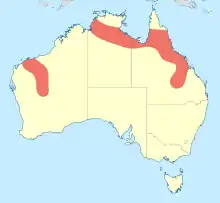| Silver wisp | |
|---|---|
 | |
| Male, Queensland | |
| Scientific classification | |
| Domain: | Eukaryota |
| Kingdom: | Animalia |
| Phylum: | Arthropoda |
| Class: | Insecta |
| Order: | Odonata |
| Suborder: | Zygoptera |
| Family: | Coenagrionidae |
| Genus: | Agriocnemis |
| Species: | A. argentea |
| Binomial name | |
| Agriocnemis argentea | |
 | |
Agriocnemis argentea is a species of damselfly in the family Coenagrionidae,[3] commonly known as a silver wisp.[4] It is a small damselfly; the male, when mature, is covered in a white pruinescence.[4] It is endemic to northern Australia[5] where it inhabits both still and flowing waters.[6]
Etymology
The species name argentea is a Latin word meaning the colour of silver. In 1906 Robin Tillyard named this species of damselfly after the beautiful silvery white bloom covering of mature adults, which when flying ... appears as a bright silver streak, darting in and out of the grass.[2][7]
Gallery
.jpg.webp) Female wings
Female wings.jpg.webp) Male wings
Male wings
See also
References
Wikimedia Commons has media related to Agriocnemis argentea.
- ↑ Dow, R.A. (2017). "Agriocnemis argentea". IUCN Red List of Threatened Species. 2017: e.T87533167A87534056. doi:10.2305/IUCN.UK.2017-1.RLTS.T87533167A87534056.en. Retrieved 19 November 2021.
- 1 2 Tillyard, R.J. (1906). "New Australian species of the family Agrionidae (Neuroptera: Odonata)". Proceedings of the Linnean Society of New South Wales. 31: 177–194 [192] – via Biodiversity Heritage Library.
- ↑ "Species Agriocnemis argentea (Tillyard, 1906)". Australian Faunal Directory. Australian Biological Resources Study. 2012. Retrieved 6 April 2017.
- 1 2 Theischinger, Günther; Hawking, John (2006). The Complete Field Guide to Dragonflies of Australia. Collingwood, Victoria, Australia: CSIRO Publishing. p. 100. ISBN 978-0-64309-073-6.
- ↑ Watson, J.A.L.; Theischinger, G.; Abbey, H.M. (1991). The Australian Dragonflies: A Guide to the Identification, Distributions and Habitats of Australian Odonata. Melbourne: CSIRO. ISBN 0643051368.
- ↑ Theischinger, Gunther; Endersby, Ian (2009). Identification Guide to the Australian Odonata (PDF). Department of Environment, Climate Change and Water NSW. p. 188. ISBN 978-1-74232-475-3.
- ↑ Endersby, Ian; Fliedner, Heinrich (2015). The Naming of Australia's Dragonflies. Eltham, Victoria, Australia: Busybird Publishing. ISBN 9781925260625.
This article is issued from Wikipedia. The text is licensed under Creative Commons - Attribution - Sharealike. Additional terms may apply for the media files.
